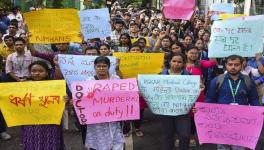Where Are Safe Spaces for Women in India?

When I moved to Delhi for my higher studies, my family and friends were deeply concerned. They often expressed their fears, saying things like, “Delhi? That’s the rape capital. Women are so unsafe there. How are you managing? Be careful, don’t go out too much, and try to come back before 6.” Over a decade later, the perception of Delhi as a dangerous place for women remains unchanged. However, a significant shift has occurred –family and friends, like others, now recognise that rape can happen anywhere — in Delhi, Hyderabad, Kolkata, or Bangalore. The reality is that no place is truly safe for women.
Despite the high-profile Nirbhaya gangrape case in 2012. and promises of reform, the situation in India has not improved significantly. The recent horrific rape and murder of a Kolkata-based intern doctor has once again shocked the nation, exposing our persistent state of stagnation and inaction.
After a wave of protests, candlelight vigils, and social media campaigns, the focus often shifts away from what happens when the outcry fades. What happens to the victim's family in the aftermath? How agonising must it be for them to navigate the bureaucratic labyrinth, trying to prove that their daughters were brutally raped and murdered? Do we truly comprehend the anguish these families endure as they face court proceedings, deal with the police, sift through charge sheets, and relive their trauma repeatedly? Parents who once proudly spoke of their daughters' future achievements, now find themselves grappling with their daughter's lifeless body, crying out for help.
Addressing the elephant in the room -- the pervasive issue of rape and its cultural acceptance in India -- is crucial. Our discussions often miss the core issue; rape cases are not merely statistics but reflect a deeply entrenched cultural problem. Various forms of rape, such as marital rape, are frequently overlooked. Additionally, the reporting of rape cases varies significantly depending on the context -- urban versus rural areas, during riots, or in regions like Jammu and Kashmir and Manipur.
Custodial rape, as exemplified by cases like Mathura (1972), Rameeza (1978), and Maya Tyagi (1980), also remains a significant issue. Moreover, marginalised groups, including Dalits and Adivasis, face troubling patterns of violence, with high-profile cases like Bilkis Bano’s in Gujarat highlighting a broader systemic issue that often gets lost in general discussions.
The problem lies in the simplistic view of what drives sexual violence, alongside assumptions about victimhood and the systems of patriarchy and cis-heteronormativity that perpetuate gender-based violence. For marginalised women, trans individuals, and those who do not conform to the 'ideal' survivor stereotype, a culture of impunity, selective outrage, and victim-blaming is perpetuated.
Justice cannot be discussed without addressing the pervasive culture that normalises and accepts violence. Social norms—the unwritten rules dictating acceptable behaviour - play a significant role in perpetuating violence. Patriarchal norms are maintained by those who benefit from the attitudes and behaviors they engender. These norms decide which survivors and perpetrators are considered to 'deserve' their fates, reinforcing a cycle of injustice.
Many, including educated individuals and political leaders, blame women for their misfortunes, citing reasons like wearing revealing clothes, interacting freely with men, or being out late. Yet, what about cases where a woman dressed decently and returning home early still suffers rape? How can we ignore the situation where a rape victim is met with shame and disregard by authorities while trying to file a complaint? Victim-blaming in India only provides more justification for perpetrators.
In Indian cinema, the objectification and sexualisation of women have become normalised to the point where it’s rare to find a film without a suggestive item number or portrayal of the female lead in revealing outfits. Women are often reduced to symbols of desire, with their roles confined to their physical allure and sexuality. This portrayal suggests that a woman's value is tied to her beauty and ability to attract male attention, diminishing her worth and reinforcing gender stereotypes. Films like Kabir Singh and Animal succeed at the box office due to their focus on women's subjugation and submissiveness with male chauvinists.
The internalisation of misogyny, where women demean each other, significantly contributes to perpetuating rape culture. When women belittle or undermine each other, they reinforce negative stereotypes and sexist attitudes that normalise and trivialise gender-based violence.
Public shaming on social media, undermining professional achievements, negative portrayals on reality TV, and community gossip contribute to perpetuating rape culture. This behaviour reinforces harmful stereotypes and social norms that devalue women, creating an environment where violence against women is more easily accepted and excused.
Caste dynamics also deeply influence many aspects of life in India, particularly in rural and tribal areas. In cases of sexual violence, caste-based rivalries, and religious tensions often drive the motivations behind these acts. Dalit women are particularly vulnerable, with their bodies frequently becoming targets of violence. For many Dalit girls, extreme violence predominantly manifests as sexual violence.
Sociologist Sanjay Srivastava explains, "Rape is fundamentally about power. When upper-caste men rape Dalit women, it is a display of power and dominance. This act also implies that Dalit men are incapable of protecting their women, turning rape into a form of competition among men" (2018).
Adivasi women face heightened violence due to poverty, marginalisation, and societal stereotypes. Their situation is exacerbated by resource exploitation, dispossession, and increased military presence in conflict zones, like Manipur, Odisha, Chhattisgarh, Andhra Pradesh, Telangana, and West Bengal.
Seeking justice is fraught with obstacles: some FIRs are not filed, particularly when police or security officials are perpetrators, and where FIRs are filed, delays of up to a year occur, as noted in a 2024 news report. Activists often have to intervene to prompt action. Despite the Supreme Court's ban on the two-finger test, almost half of rape survivors still endure it, and many face delays or lack of medical examinations, leading to lost forensic evidence and inadequate police support. Some rape cases receive public attention due to their location, while many remote Adivasi and rural areas experience routine sexual violence that goes unnoticed. This raises the question of whether activism is selectively focused on certain cases, leaving many women in marginalised areas without justice.
Legal loopholes in rape cases often undermine the effectiveness of the justice system, contributing to the perpetuation of sexual violence. Issues such as inadequate definitions of consent, low conviction rates, high acquittal rates and bails, delays in forensic examinations, and insufficient victim protection can result in perpetrators escaping accountability. For example, the lack of rigorous implementation of legal safeguards, like prompt filing of FIRs or immediate medical examinations, can lead to lost evidence and diminished chances of prosecution.
Procedural delays and Kafkaesque administrative inefficiencies bureaucratic inefficiencies discourage survivors from pursuing justice, perpetuating a cycle where perpetrators face little to no consequences, thus encouraging further offenses. The troubling practice of garlanding and celebrating rapists as heroes undermines efforts to combat sexual violence. This glorification of perpetrators creates a dangerous environment where justice is obstructed, making it increasingly difficult to address and prevent new cases of rape.
To address this issue effectively, we must challenge the cultural acceptance of rape. The urgent need of the hour is; that the nation must move beyond symbolic representations of women like Kali, Durga, Lakshmi, and Saraswati, and instead offer genuine respect and equality.
The writer is Assistant Professor, Department of Sociology, Maitreyi College, University of Delhi. The views are personal.
Get the latest reports & analysis with people's perspective on Protests, movements & deep analytical videos, discussions of the current affairs in your Telegram app. Subscribe to NewsClick's Telegram channel & get Real-Time updates on stories, as they get published on our website.
























